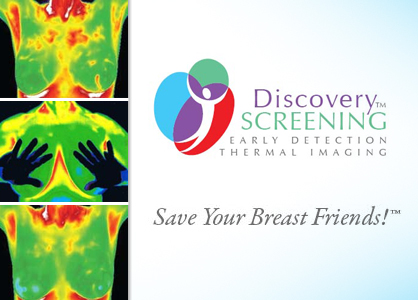Mammograms and Thermograms: Knowing the difference could save your breasts
Lisa Kalison discovered thermography as a patient. Just like many women in the United States, getting a mammogram was an automatic step for her. At age 35, her gynecologist referred her. Unaware of the alternatives, she went.
“He thought he was doing me a favor by ‘starting me early.’ Till I had it done, and I thought ‘There is something seriously wrong with this technology. I am never doing this again,’” Kalison said.
The way her breasts were compressed didn’t make sense to her – and neither did the radiation that was blasted through her breasts.
“I couldn’t help but think, ‘Oh, my gosh, this is the most distressed you can make the breast tissue.’ And they’re zapping it with the most intense and damaging ionizing radiation known to medical imaging,” Kalison said.
At age 40, she began to look for another way. She knew she needed to monitor the health of her breasts, but felt mammograms weren’t the right path for her. That’s when she discovered thermography.
Then she found her own lump.
“It was an interesting scare for me … I went to my gynecologist, a little guarded,” Kalison said. “With a look of terror on her face, she said, ‘Oh my, we need to refer you to a breast surgeon.’ And I said, ‘A breast surgeon? C’mon. Aren’t we skipping a few steps here?’”
She decided to go to her thermographer first to see if there was any metabolic activity. Her Thermal Images showed nothing that would indicate a concern. She felt reassured, but wanted an ultrasound as an added precaution. The ultrasound verified it was a fluid cyst and, combined with the Thermal Image, gave her that 100-percent peace of mind. Within a few months, the cysts were gone on their own. Today she is a certified clinical thermographer and owner of Discovery Screening Thermal Imaging.
The way thermograms work is by sensing the heat patterns of your body. The examination room is kept at a temperature of 68 to 72 degrees, allowing the skin to cool down so that the capillaries at the surface of the skin constrict. This provides the contrast between hot and cold required for the thermogram to do its magic. Thermal imaging actually sees the energy of the hot and cold patterns and converts that to high-definition digital form on a screen, which can then be analyzed. Cold spots could indicate tumors, which, having no blood supply within the tumor, show up as cold and dense.
The imaging is fast, like a photography session, with a small, nonthreatening camera that captures an image.
Mammograms, like ultrasounds and MRIs, are an anatomical device. These methods can only see solid mass.
“They cannot see the metabolic activity associated with the immune system&ssquo;s natural process of healing, which commonly shows up as inflammation, or vascularity that shouldn’t be there. They cannot display what is going on beyond just seeing the presence of a lump,” Kalison said.
But by the time enough cancer cells have amassed into a detectable lump, the cancer may have been there and growing for years.
Kalison reports that cancer cells are microscopic: A billion cancer cells fit on the head of a pin. It takes six to seven years for that many cancer cells to accumulate. The soonest it can thus be detected by these three traditional devices is around eight years—an estimated 4 billion cancer cells.
“So mammography is basically misrepresenting itself as an early detection tool. It’s not early detection. It’s late discovery at best,” Kalison said.
In contrast, thermography is a physiological device. Thermography actually detects the energy coming off your skin in the form of thermal patterns.
“We can see the metabolic activity of the immune system at work years before disease ever occurs and before degeneration and cancer occur. So we can see that early enough to guide someone toward preventative, less invasive, less costly care, Kalison said. “So it’s helping women keep their breasts intact and on their body where they belong.”
In her own research, she’s discovered around 40 percent of breast procedures are completely unnecessary, due to mammogram’s high incidence of false-positives.
“Thermography is a red flag raiser. If something looks suspect, you go to the next level of discovery,” Kalison said, maintaining that “thermal imaging is not intended to diagnose cancer, but to illuminate the earliest warning signs before it becomes cancer or, if cancer is already present, to see the earliest possible indicators before any other screening device can see it.”
Thermography is remarkably affordable and a lower out-of-pocket investment than mammograms and the other devices. Most major PPO insurances will cover 30%-80% of the fees. Avoiding the time lost and pain endured of managing a breast disease or cancer could be more than worth it.
For more information, contact Discovery Screening at www.discoveryscreening.com.
Tagged in: lux exclusives, breast cancer, breasts, mammogram, discovery screening, lisa kalison, thermogram, thermography,

Purple Neon/LadyLUX via Discovery Screening



